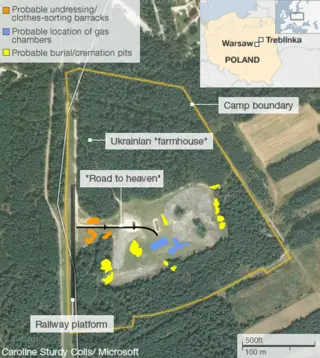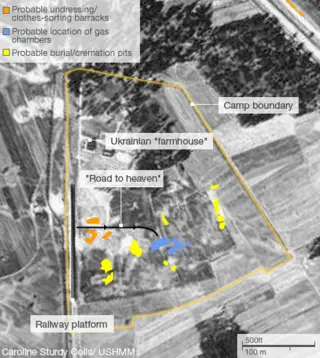What Mattogno chose to publish, in the book "The Operation Reinhardt Camps" about the 1945 survey led by Judge Lukaszkiewwicz;
https://holocausthandbooks.com/wp-conte ... 8-torc.pdf
"“Protocol of the Tasks Performed on the Grounds of the Death Camp Treblin-
ka, Which Forms the Object of the Judicial Examination.
From November 9 to 13, 1945, the examining magistrate of Siedlce, Z. Łukasz-
kiewicz, together with the state attorney for the District Court of Siedlce, J.
Maciejewski, performed the following tasks on the camp grounds:
1) November 9, 1945
Excavations were begun on the grounds using the services of 20 workers who
had been mustered by the village administration for carrying out roadwork.
The excavations began at the location described by the witness Rajzman on
November 6, where the so-called ‘camp hospital’ had stood and where, ac-
cording to the witness, a mass grave is supposed to exist. Since a bomb crater
4.5 meters deep is present at the said location – two bombs still lie at a slight
distance from this crater – the digging was begun in this crater. In the course
of this work numerous Polish, as well as Russian, German, Austrian, and
Czech coins and broken pieces of various kinds of containers were discovered.
At the end of the work, at approximately 3 pm, at a depth of 6 meters, we en-
countered a layer which had not been reached previously. No human remains
were found.
2) November 10, 1945
The work was continued, with 36 workers who had been commandeered for
roadwork. At a depth of 6 meters begins a layer which has never before been
uncovered by anyone. It consists partly of all sorts of kitchen utensils and dif-
ferent kinds of household objects; there are also pieces of clothing. At a depth
of 7 meters, we reached the bottom of the pit – a layer of yellow sand which is
not mixed with gravel. By additional digging we succeeded in determining the
shape of the pit. It has sloping walls, and the bottom measures about 1.5 meters
[sic!]. The pit was presumably dug out with an excavator. During the course of
the excavations, numerous more-or-less-badly damaged Polish documents
were discovered, in addition the badly damaged personal identity card of a
German Jew, as well as several more coins: Polish, German, Russian, Belgian,
and even American. After we had made certain that this pit, filled with broken
pieces of the containers already mentioned, ran in a north-south direction on
the grounds of the camp area – 2 meters more [in a northerly direction] had
been excavated – the workers started work at this location.
3) November 11, 1945
A series of test excavations was performed at the place where the [gas] cham-
bers had to have been located, in order to find their foundation walls if possi-
ble. Pits 10 – 15 meters in length and 1.5 meters deep were dug, uncovering
undisturbed layers of earth.
The largest of the craters produced by explosions – from this emerges numer-
ous pieces of shrapnel –, which is 6 meters deep and has a diameter of about
25 meters, its walls give recognizable evidence of the presence of a large quan-
tity of ashes as well as human remains – was further excavated in order to dis-
cover the depth of the pit in this part of the camp. Numerous human remains
were found by these excavations, still partially in a state of decomposition [w
stanie rozkładu]. The soil consists of ashes interspersed with sand, and is of a
dark-gray color, granular in form. During the excavations, the soil gave off an
intense odor of burning and decay. At a depth of 7.5 meters the bottom was
reached, which consisted of layers of unmixed sand. At this point the digging
was stopped.
4) November 13, 1945
With the assistance of 30 workers employed for roadwork, the opening of a pit
was begun – a site where refuse was deposited in the northeastern section of
the camp. In this location, as the workers from the nearby hamlets explained, a
very large number of documents had been found so far. Work was begun at this
location, where the people [of that area] had dug a three-meter-deep pit in a
search for gold. During the course of the digging, broken pieces of all sorts of
kitchen containers as well as a large number of rags were found. Aside from
the coins discovered so far, Greek, Slovakian, and French ones were found, as
well as documents in Hebrew and Polish and remnants of a Soviet passport. At
a depth of 5 meters the work was stopped due to the steadily worsening weath-
er conditions.
The Examining Judge The State Attorney
Łukaszkiewicz Maciejewski
Decision:
The Examining Judge of Siedlce, on November 13, 1945, rules in consideration
of the fact that with great probability no mass graves are any longer to be
found on the grounds of the former camp today, as is to be concluded from the
witness testimonies examined so far and from the results of the work carried
out at the site, and in consideration of the oncoming autumn, the present rain-
fall and the necessity of a rapid conclusion of the judicial preliminary investi-
gations, in view of all these facts that work on the territory of the former death
camp Treblinka is to stop.
The Examining Judge
Łukaszkiewicz.”
"With the assistance of an expert surveyor and witnesses, I made an exact in-
spection of the terrain. According to the measurements, the area of the camp is
approximately 13.45 hectares and had the shape of an irregular quadrilateral.
No remnants of facilities of the former death camp exist any longer. The only
things that remain of the structures are: a ditch with remains of burned wooden
poles protruding up, which lead into the cellar, wall bricks from the founda-
tions of the camp’s housekeeping building and the site of the well. Here and
there one finds traces of the burned-out wooden poles of the fence and remains
of barbed wire. There are still a few sections of paved walks. Nonetheless,
there are still other traces that hint at the existence and functions of the camp.
In the northwestern section of the area, the surface is covered for about 2 hec-
tares by a mixture of ashes and sand. In this mixture, one finds countless hu-
man bones, often still covered with tissue remains, which are in a condition of
decomposition. During the inspection, which I made with the assistance of an
expert in forensic medicine, it was determined that the ashes are without any
doubt of human origin (remains of cremated human bones). The examination of
human skulls could discover no trace of wounding. At a distance of some 100
m, there is now an unpleasant odor of burning and decay. In the southwestern
direction, a portion of the camp terrain is covered by aluminum – enamel –
glass and porcelain dishes – kitchen utensils – hand luggage – rucksacks –
pieces of clothing, etc. There are innumerable holes and craters on the proper-
ty.” (Emphases added)
“During the work on the terrain, I found no mass graves, which, in connection
with the statements by the witnesses Romanowski and Wiernik, leads to the
conclusion that nearly all of the bodies of the victims were burned, all the more
so since the camp was liquidated early and the murderers had much time. The
ground of the camp was ploughed and sown. Ukrainians were settled there;
they fled before the arrival of the Red Army (witnesses Kucharek and
Lopuszyński).”
"“Due to the destruction of the graves, it is not possible to count the bodies
which have been there. The medical expert Mieczysław Piotrowski affirms,
however, that one grave of 2 × 1 × 1 m (without taking into consideration the
upper level of earth which covers the bodies) contains at least 6 nude bodies.
Considering the size of all 41 graves, and under the assumption that the levels
of corpses reach only up to 1.5 m in depth (the depth of the graves is up to 3
m), one can calculate that at least 6,500 people were buried there.”
The so-called revisionists will cherry-pick parts of the report and ignore much of it, as it does not fit with their desired beliefs. They will ignore that the 1945 finds, are corroborated by eyewitnesses, an aerial photo and the 2011 survey. They prove that TII had the space, to bury c850,000 corpses.

